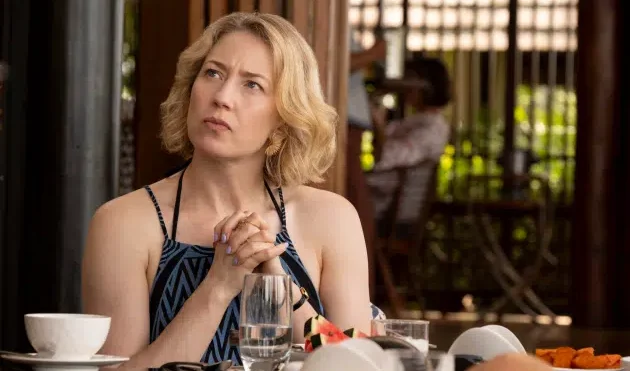Carrie Coon, the acclaimed actress known for her roles in The Leftovers and The Gilded Age, has shared new details about her character, Laurie, in The White Lotus Season 3. In a recent interview with Harper’s Bazaar, Coon revealed that Laurie’s character was originally written to have a nonbinary or transgender child, a storyline that was eventually scrapped by creator Mike White. The decision to alter the plot came in the wake of Donald Trump’s re-election, a period marked by increasing anti-transgender sentiment in the United States.
Laurie, who is part of a toxic trio of female friends known as the “Blonde Blob” in the latest season, is grappling with numerous personal struggles. From a looming divorce to a frustrating career and a strained relationship with her daughter, Laurie’s character is undeniably complex. However, the originally conceived storyline, which delved into Laurie’s challenges surrounding her nonbinary or possibly transgender child, was intended to add an additional layer to her character’s narrative.
According to Coon, the character’s original arc involved Laurie’s daughter identifying as nonbinary, possibly transgender, and using they/them pronouns. “There was a bit more context to her home life,” Coon explained, revealing that viewers would have seen Laurie attempting to understand her child’s gender identity. The actress noted that Laurie would struggle to use the appropriate pronouns, which would have provided insight into her internal conflict and emotional journey. Coon found the original storyline intriguing, believing it would have added emotional depth to Laurie’s character, particularly in a scene that revolved around Laurie’s personal animosity toward another character, Kate.
In the original storyline, the question of whether Kate, another character in the show, voted for Trump would have been much more personally charged for Laurie, given her child’s identity in a world that is often hostile to transgender and nonbinary people. According to Coon, this would have made the interaction between Laurie and Kate more provocative and emotionally loaded. “It did make the question of whether Kate voted for Trump so much more provocative and personally offensive to Laurie, considering who her child is in the world,” Coon shared.
However, the decision to cut this plotline came after Trump’s re-election, a time when the political climate in the United States became more hostile toward transgender and nonbinary individuals. Coon explained that the storyline was conceived before Trump’s second term in office, during a time when the administration’s policies were beginning to shape public discourse around gender identity. “The season was written before the election,” Coon said. “And considering the way the Trump administration has weaponized the cultural war against transgender people even more since then, when the time came to cut the episode down, Mike [White] felt that the scene was so small and the topic so big that it wasn’t the right way to engage in that conversation.”
White’s decision to remove the scene from the final cut of The White Lotus was driven by a desire to approach the subject matter with greater care and sensitivity. The portrayal of transgender and nonbinary experiences requires thoughtful, nuanced storytelling—something that, according to Coon, the original scene was not able to fully encapsulate. White, recognizing the importance of handling such a significant topic with respect and depth, felt that it was not the right moment for the scene to be part of the narrative. As a result, the episode was trimmed down, and the storyline surrounding Laurie’s nonbinary or transgender child was removed.
Coon’s reflection on this shift highlights the broader cultural context in which the decision was made. The political landscape during Trump’s presidency saw an intensification of anti-transgender rhetoric, with policies that targeted the rights and recognition of transgender individuals. Among the most contentious issues were the rollback of protections for transgender people in healthcare, education, and employment. The Trump administration’s rhetoric often portrayed transgender rights as a threat to societal norms, fostering an environment of fear and division.
For example, the removal of information about transgender and intersex individuals from government websites and the issuance of controversial statements such as the White House’s “Defending Women From Gender Ideology Extremism And Restoring Biological Truth” document signaled a deliberate effort to erase or marginalize the transgender community. Additionally, instances such as actress Hunter Schafer’s experience of receiving a passport that misgendered her further exemplified the real-world impact of these policies on transgender individuals.
Given this political and social climate, Coon’s insight into the decision to cut the scene is particularly poignant. The decision reflects the need for sensitivity when addressing issues related to gender identity, especially when the conversation is shaped by such a divisive political context. As Coon put it, the topic of Laurie’s child was simply too big to tackle in a brief scene, and White ultimately felt that the show’s narrative would have been better served by a more nuanced approach.
The White Lotus has become a cultural touchstone for its exploration of privilege, power dynamics, and the complexities of human relationships. While the show is primarily known for its dark comedy and biting social commentary, it also provides a platform for discussing important societal issues, including gender identity and the challenges faced by marginalized communities. Although the original storyline involving Laurie’s child was removed, Coon’s comments shed light on how the show, as well as other media, must navigate the difficult terrain of representation and the responsibility that comes with telling stories about vulnerable communities.
In a broader sense, the conversation surrounding Laurie’s character arc underscores the ongoing challenges that transgender and nonbinary individuals face in media representation. As the cultural conversation around gender identity continues to evolve, it is crucial for creators to approach these stories with care and respect. The decision to remove the original storyline in The White Lotus serves as a reminder that while representation is important, the way these stories are told—and the broader cultural context in which they are presented—must always be considered.
Carrie Coon’s insights into the character of Laurie offer a glimpse into the complexities of portraying transgender and nonbinary experiences in contemporary media. As society continues to grapple with issues of gender identity and representation, the role of television and film in shaping public perception will remain as important as ever.

Recommended for you
He Photographed Naked Straight Men—And Changed Queer History Forever by Rainbow Media
The provocative art of physique photographer Dave Martin.
Read on Substack





